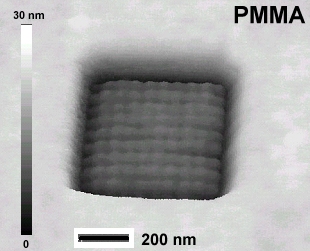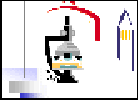
Contact Info
Adam P. Hitchcock
Canada Research Chair
in Materials Research
CLS-CCRS
B.I.M.R
McMaster University
Hamilton, ON
Canada L8S 4M1
V: +1 905 525-9140
x24729
F: +1 905 521-2773
E: aph@mcmaster.ca
U: unicorn.mcmaster.ca
__________
Research
Group
Opportunities
Publications
Links
_____________

X-ray patterning with 30 nm resolution
WHO: Adam Leontowich, Adam Hitchcock, Harald Stover

Chemistry
& BIMR, McMaster University
WHERE: ALS Scanning Transmission X-ray Microscope
(STXM) 5.3.2
WHEN: June 2009
POSTED: 30 Sep 2009
WHAT: Low dose & chemical development shows STXM-based patterning achieves 30 nm resolution
The PhD thesis research of Jian Wang showed that tunable synchrotron light focused in a STXM can generate chemically selective patterns in multi-layer polymer structures [1,2]. However , the spatial resolution achieved was 150 nm or worse, due to radiation damage spreading and the need to use high doses to have sufficient contrast for STXM analysis. Adam Leontowich has found if patterns are generated by STXM and then chemically developed, much higher spatial resolution can be achieved - but the development is not actually needed to show high resolution. The figure shows an AFM image (Quescant 350) of a 10x10 shot damage pad burned into a 40 nm thin film of PMMA using a dose of 120 MGy (200 ms @ 11 MHz, 300eV) - prior to chemical development. Each individual damage exposure (30 ms) is visualized. With appropriate methodology patterns with features as sharp as the known spatial resolution of STXM (30 nm) can be made.
OTHER INFORMATION: Chemically selective patterning has been
described in:
1. J. Wang, H.D.H. Stöver, A.P. Hitchcock and T. Tyliszczak. Chemically
selective soft X-ray patterning of polymers, J. Synchrotron
Radiation 14 (2007) 181
2. J. Wang, H.D.H. Stöver and A.P. Hitchcock, Chemically
selective soft X-ray direct-write patterning of multilayer polymer
films, J. Phys. Chem. C 111 (2007) 16330
© 2009 A.P. Hitchcock / McMaster University
- All Rights Reserved
web site design by Christopher Amis (2002). Last updated on 29 Sep 2009
(aph)

